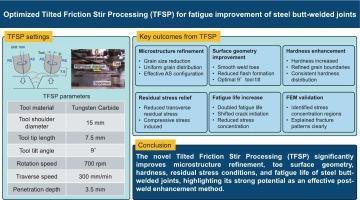优化倾斜搅拌摩擦工艺改善钢对接焊接接头的疲劳性能
IF 6.8
2区 材料科学
Q1 ENGINEERING, MECHANICAL
引用次数: 0
摘要
在钢结构焊接接头中,由几何不连续和拉伸残余应力引起的应力集中严重影响循环荷载作用下的耐久性。搅拌摩擦处理(FSP)越来越被认为是一种有效的焊后处理方法,通过改善接头的微观组织和改善接头的几何形状来提高接头的完整性。本研究提出了一种倾斜搅拌摩擦加工(TFSP)配置,该配置使用9°刀具倾斜并将推进侧放置在焊缝脚趾附近,以优化钢对接焊接接头的显微组织细化和疲劳性能。TFSP使用球形头WC工具进行,速度为700 rpm,横移速度为300 mm/min。进行了显微组织分析,表面几何表征,维氏硬度测试和残余应力测量。结果表明:TFSP改善了焊缝趾部组织,提高了热影响区(HAZ)的维氏硬度,降低了残余应力;由有限元分析(FEM)支持的四点弯曲疲劳试验表明,适当处理的试样的疲劳寿命大约是未经处理的焊接试样的两倍。这些发现强调了TFSP是一种实用有效的结构钢焊接强化技术,并阐明了提高疲劳寿命的机制。本文章由计算机程序翻译,如有差异,请以英文原文为准。

Optimized tilted friction stir processing for fatigue improvement of steel butt-welded joints
In welded joints of steel structures, stress concentrations caused by geometric discontinuities and tensile residual stresses strongly influence durability under cyclic loading. Friction stir processing (FSP) is increasingly recognized as an effective post‑weld treatment for enhancing joint integrity by refining microstructures and improving joint geometry. This study proposes a tilted friction stir processing (TFSP) configuration that uses a 9° tool tilt and places the advancing side near the weld toe to optimize microstructural refinement and fatigue performance in steel butt‑welded joints. TFSP was performed with a spherical‑tipped WC tool at 700 rpm and a traverse speed of 300 mm/min. Microstructural analysis, surface‑geometry characterization, Vickers hardness testing, and residual‑stress measurements were conducted. The results show that TFSP improved the microstructure at the weld toes, increased Vickers hardness in the heat‑affected zone (HAZ), and reduced residual stress. Four‑point bending fatigue tests, supported by finite element analysis (FEM), demonstrated that appropriately treated specimens achieved approximately twice the fatigue life of untreated welded specimens. These findings highlight TFSP as a practical and effective enhancement technique for structural steel weldments and clarify the mechanisms responsible for fatigue life improvement.
求助全文
通过发布文献求助,成功后即可免费获取论文全文。
去求助
来源期刊

International Journal of Fatigue
工程技术-材料科学:综合
CiteScore
10.70
自引率
21.70%
发文量
619
审稿时长
58 days
期刊介绍:
Typical subjects discussed in International Journal of Fatigue address:
Novel fatigue testing and characterization methods (new kinds of fatigue tests, critical evaluation of existing methods, in situ measurement of fatigue degradation, non-contact field measurements)
Multiaxial fatigue and complex loading effects of materials and structures, exploring state-of-the-art concepts in degradation under cyclic loading
Fatigue in the very high cycle regime, including failure mode transitions from surface to subsurface, effects of surface treatment, processing, and loading conditions
Modeling (including degradation processes and related driving forces, multiscale/multi-resolution methods, computational hierarchical and concurrent methods for coupled component and material responses, novel methods for notch root analysis, fracture mechanics, damage mechanics, crack growth kinetics, life prediction and durability, and prediction of stochastic fatigue behavior reflecting microstructure and service conditions)
Models for early stages of fatigue crack formation and growth that explicitly consider microstructure and relevant materials science aspects
Understanding the influence or manufacturing and processing route on fatigue degradation, and embedding this understanding in more predictive schemes for mitigation and design against fatigue
Prognosis and damage state awareness (including sensors, monitoring, methodology, interactive control, accelerated methods, data interpretation)
Applications of technologies associated with fatigue and their implications for structural integrity and reliability. This includes issues related to design, operation and maintenance, i.e., life cycle engineering
Smart materials and structures that can sense and mitigate fatigue degradation
Fatigue of devices and structures at small scales, including effects of process route and surfaces/interfaces.
 求助内容:
求助内容: 应助结果提醒方式:
应助结果提醒方式:


